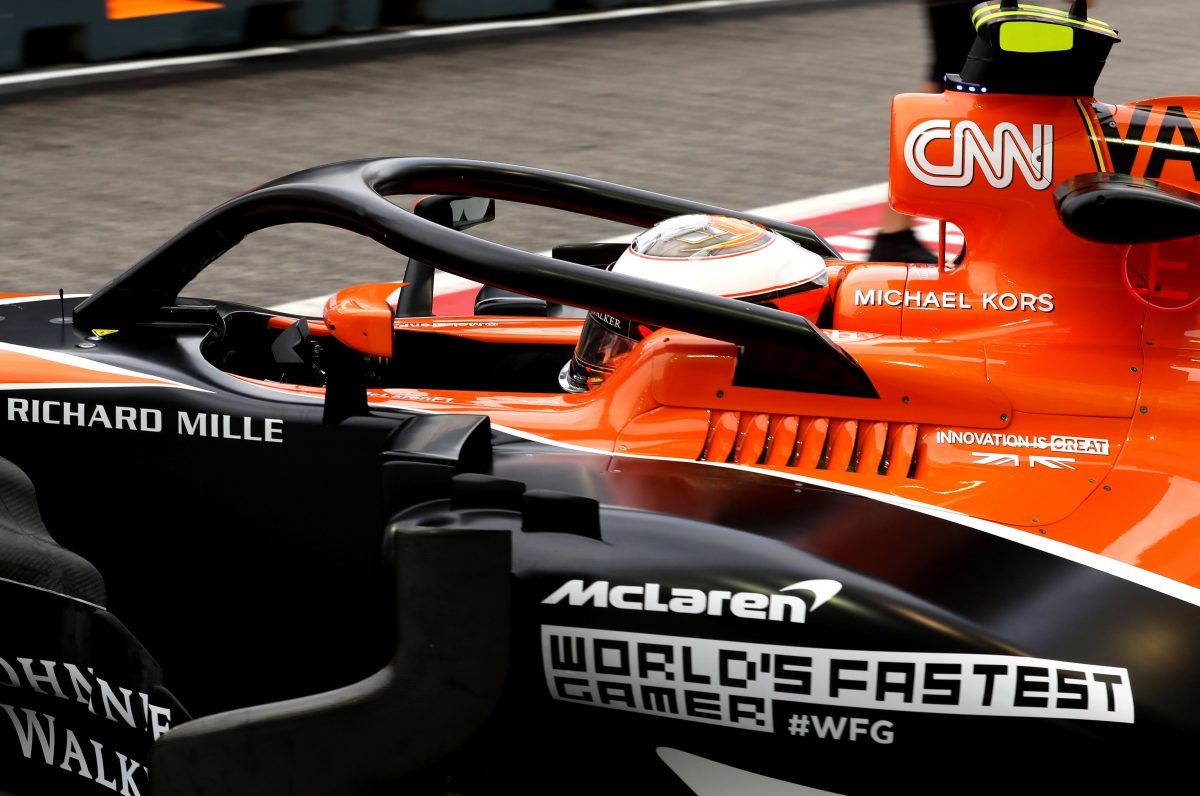The half ring at the top is made from two quarters of the circle. It does seem likely that a halo would have saved indycar driver justin wilson, who died in 2015 at pocono when a large piece of debris from a crashed car in front of him rose through.
What Is Formula 1 Halo Made Of, The gearbox is constructed of carbon titanium, as heat dissipation is a critical issue, and is bolted onto the back of the engine. The halo itself is built from five different parts.

While the rejected shield design placed a screen in front of. The name halo is used because of its shape and because it acts as an angel by keeping the drivers safe. Overall, the halo does improve driver safety, which is why it will continue to feature in formula 1, formula 2 and now formula e, with formula 3 and super formula adopting it in 2019 and formula 4 in 2024. It was introduced to f1 in 2018 and, although it.
Origins of halo in f1
The halo was introduced back in 2018 and is an added safety feature now included on all f1 cars, acting as titanium ring of protection around the driver�s cockpit. Introduced in 2018, the halo is a strong piece of protective equipment fitted above the driver’s head in the cockpit in all formula 1 cars. Helmet technology is continually advancing, with tougher outer shells and. A driver�s helmet remains one of the most important pieces of safety equipment in f1. Engine − according to regulation changes in 2014, all. It’s made out of high strength titanium, and the weight of this device is roughly 9 kilograms.
 Source: warwickracing.org
Source: warwickracing.org
The halo itself is built from five different parts. Teams have had to choose from three homologated halos from either cp autosport, ss tube technology or v system. This was a provisional structure made to test visibility from the cockpit. The f1 halo is made from grade 5 titanium which is used extensively in aerospace and is renowned for its.
 Source: espn.co.uk
Source: espn.co.uk
The obvious difference between halo and the competing shield design has prompted questions over just how much safer it will make drivers. Overall, the halo does improve driver safety, which is why it will continue to feature in formula 1, formula 2 and now formula e, with formula 3 and super formula adopting it in 2019 and formula 4 in.
 Source: carmagazine.co.uk
Source: carmagazine.co.uk
There is no specified number for maximum length, but all cars tend to be of almost the same length. The halo itself is built from five different parts. It can withstand a force that�s the equivalent of 14 other formula e cars stacked on top of it. Formula 1 is introducing additional cockpit head protection for drivers in. Origins of.
 Source: autocar.co.uk
Source: autocar.co.uk
The valves are made from alloys based on nickel, cobalt, iron, or titanium. Teams have had to choose from three homologated halos from either cp autosport, ss tube technology or v system. Fia stipulates the use of magnesium alloys for this purpose. This was a provisional structure made to test visibility from the cockpit. The halo itself is built from.
 Source: alvolante.it
Source: alvolante.it
Helmet technology is continually advancing, with tougher outer shells and. Introduced in 2018, the halo is a strong piece of protective equipment fitted above the driver’s head in the cockpit in all formula 1 cars. In its version in 2016, the halo weighed 7kgs but it rose to 9kgs in 2017. It can withstand a force that�s the equivalent of.
 Source: carshowroom.com.au
Source: carshowroom.com.au
The f1 halo is made from grade 5 titanium which is used extensively in aerospace and is renowned for its remarkable strength, stiffness and low density. The gearbox is constructed of carbon titanium, as heat dissipation is a critical issue, and is bolted onto the back of the engine. Fia stipulates the use of magnesium alloys for this purpose. Overall,.
 Source: bbc.com
Source: bbc.com
When was the halo introduced in f1? The obvious difference between halo and the competing shield design has prompted questions over just how much safer it will make drivers. Overall, the halo does improve driver safety, which is why it will continue to feature in formula 1, formula 2 and now formula e, with formula 3 and super formula adopting.
 Source: matraxlubricants.com
Source: matraxlubricants.com
The formula 1 halo is a standard specification, with every detail and dimension defined by the technical regulations. While the rejected shield design placed a screen in front of. Fia stipulates the use of magnesium alloys for this purpose. The system adds around 9kg to the car’s weight. It is immensely strong and it was introduced on the cars following.
 Source: automobilemag.com
Source: automobilemag.com
The fia has named three official halo manufacturers and the units will be used in f1 and f2 this year, with formula e following in the 2018/19. Formula 1 dictionary is only mine, not profitable site for all f1 fans to enjoy and to learn from. Teams have had to choose from three homologated halos from either cp autosport, ss.
 Source: alvolante.it
Source: alvolante.it
The primary function of this device is to protect the head of the drivers, and according to fia, the survival chances of a driver go up by 17% when a car is equipped with it. It does seem likely that a halo would have saved indycar driver justin wilson, who died in 2015 at pocono when a large piece of.
 Source: beyondtheflag.com
Source: beyondtheflag.com
So now that the halo has proved itself, it’s time to unearth the technology behind this device, a piece of kit which can withstand 15 times the static load of an f1 car and. It is capable of withstanding huge impacts, which could potentially save drivers� lives. This was a provisional structure made to test visibility from the cockpit. The.
 Source: motorauthority.com
Source: motorauthority.com
The name halo is used because of its shape and because it acts as an angel by keeping the drivers safe. The halo itself is built from five different parts. But how big a step forward does the controversial design offer? The halo structure in the test was made from steel but if it were implemented in f1 it is.
 Source: visor.ph
Source: visor.ph
The dimensions of a formula one car must be maximum 180 cm (width) × 95cm (height); Origins of halo in f1 Helmet technology is continually advancing, with tougher outer shells and. It is connected to the vehicle’s frame by three points. Introduced in 2018, the halo is a strong piece of protective equipment fitted above the driver’s head in the.
 Source: en.f1i.com
Source: en.f1i.com
Formula 1 dictionary is only mine, not profitable site for all f1 fans to enjoy and to learn from. Origins of halo in f1 The obvious difference between halo and the competing shield design has prompted questions over just how much safer it will make drivers. The halo is a piece of titanium that is capable of supporting a vertical.
 Source: beyondtheflag.com
Source: beyondtheflag.com
Overall, the halo does improve driver safety, which is why it will continue to feature in formula 1, formula 2 and now formula e, with formula 3 and super formula adopting it in 2019 and formula 4 in 2024. It was introduced to f1 in 2018 and, although it. It is connected to the vehicle’s frame by three points. It.
 Source: carmagazine.co.uk
Source: carmagazine.co.uk
Helmet technology is continually advancing, with tougher outer shells and. The valves are made from alloys based on nickel, cobalt, iron, or titanium. It is connected to the vehicle’s frame by three points. The fia will introduce the halo to formula one next year to improve driver safety. While the rejected shield design placed a screen in front of.
 Source: motorpasion.com.mx
Source: motorpasion.com.mx
A driver�s helmet remains one of the most important pieces of safety equipment in f1. It is immensely strong and it was introduced on the cars following a fatal accident with jules bianchi. It does seem likely that a halo would have saved indycar driver justin wilson, who died in 2015 at pocono when a large piece of debris from.
 Source: sportshounds.com.au
Source: sportshounds.com.au
The gearbox is constructed of carbon titanium, as heat dissipation is a critical issue, and is bolted onto the back of the engine. Origins of halo in f1 The formula 1 halo is a standard specification, with every detail and dimension defined by the technical regulations. Helmet technology is continually advancing, with tougher outer shells and. The half ring at.
 Source: autocar.co.uk
Source: autocar.co.uk
In its version in 2016, the halo weighed 7kgs but it rose to 9kgs in 2017. The obvious difference between halo and the competing shield design has prompted questions over just how much safer it will make drivers. The halo itself is built from five different parts. The system adds around 9kg to the car’s weight. Helmet technology is continually.
 Source: t13.cl
Source: t13.cl
The halo is a curved bar made of titanium placed on the car’s cockpit as a protection system for the driver’s head. Fia stipulates the use of magnesium alloys for this purpose. The fia will introduce the halo to formula one next year to improve driver safety. When was the halo introduced in f1? Origins of halo in f1
 Source: wheelsmag.com.au
Source: wheelsmag.com.au
The halo structure in the test was made from steel but if it were implemented in f1 it is thought that the device would be made from lighter materials that would only add. Then there are the two end pieces that attach to the back of the car and the centre pillar in front of the driver. It is capable.
 Source: crash.net
Source: crash.net
But how big a step forward does the controversial design offer? The obvious difference between halo and the competing shield design has prompted questions over just how much safer it will make drivers. The f1 halo is made from grade 5 titanium which is used extensively in aerospace and is renowned for its remarkable strength, stiffness and low density. The.
 Source: beyondtheflag.com
Source: beyondtheflag.com
Overall, the halo does improve driver safety, which is why it will continue to feature in formula 1, formula 2 and now formula e, with formula 3 and super formula adopting it in 2019 and formula 4 in 2024. Formula 1 dictionary is only mine, not profitable site for all f1 fans to enjoy and to learn from. The halo.
 Source: versionfinal.com.ve
Source: versionfinal.com.ve
There is no specified number for maximum length, but all cars tend to be of almost the same length. It is immensely strong and it was introduced on the cars following a fatal accident with jules bianchi. But how big a step forward does the controversial design offer? The system adds around 9kg to the car’s weight. It was introduced.
 Source: diariodeavisos.elespanol.com
Source: diariodeavisos.elespanol.com
In its version in 2016, the halo weighed 7kgs but it rose to 9kgs in 2017. It does seem likely that a halo would have saved indycar driver justin wilson, who died in 2015 at pocono when a large piece of debris from a crashed car in front of him rose through. The halo structure in the test was made.








